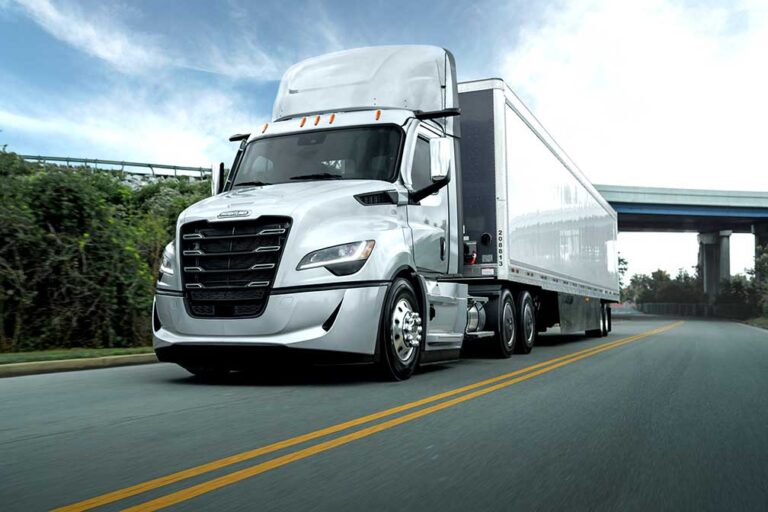February was a tough month for truck dealers, with U.S. sales of new Class 8 tractors hitting the lowest point (15,725 units) since February 2022. According to data received from Wards Intelligence.
Back in 2022, sales rose quickly the following month — and 2022 ended with total sales of 254,574. It’s doubtful we’ll see a repeat this year.
A classic story of supply and demand
For those who are anticipating increased freight rates, declining sales of new trucks is a good thing. When rates — and profits — skyrocketed in 2020, carriers bought all the trucks they could and ordered more so they could take advantage.
The resulting oversupply of trucks far exceeded the demands of shippers, driving rates downward and holding them there.
Major for-hire carriers started downsizing their fleets, but the private carriers — those that haul their own products — did the opposite. After paying record per-mile rates to move their products during the COVID-19 pandemic, and determined not to get caught short again, they increased the size of their fleets.
Some companies that had turned their shipping over to dedicated carriers in the years before COVID actually resurrected their own fleets. At a time when for-hire carriers were scrambling for freight to pay the bills, private fleets were offering fewer loads to the market, helping hold rates down.
Impending government mandates for better fuel efficiency and reduced emissions didn’t help. The new technology and the extended warranties expected to meet “useful life” mandates, were predicted to raise the price of 2027 model year trucks by $30,000 or more. Carriers planned to purchase more 2025 and 2026 models in an attempt to delay the pricing pain as long as possible.
At a time when freight rates dictated buying fewer trucks, the capacity glut continued.
And now, the good news
January sales of new Class 8 trucks lagged behind January 2024 by 13%. February sales declined year-over-year by another 10.7%. For the year to date, 11.9% fewer tractors were sold.
That’s good news for those who are longing for improved rates.
More good news is the announcement by EPA Administrator Lee Zelden and Secretary of Transportation Sean Duffy that mandates for increased fuel efficiency and reduced greenhouse gases (GHG) will be reviewed and either delayed or scrapped entirely.
The expected “pre-buy” of new trucks may not happen.
Tariff wars
Tariffs are getting lots of headlines these days, and for good reason.
President Donald Trump has announced 25% tariffs on vehicles and vehicle parts manufactured in Canada and Mexico, along with additional tariffs against China.
While implementation of these tariffs has been delayed twice, if the tariffs go into full effect, the cost of new trucks and automobiles are expected to skyrocket — at least on a temporary basis.
Eventually, other sources for parts can be found and manufacturers can move some assembly that is occurring in other countries to plants located in the U.S. In other cases, the governments of Canada and Mexico can lower their tariffs on U.S. goods or come to some compromise with the U.S. government.
The uncertainty of pricing, potential tariffs and the economy is likely to suppress truck sales for at least several months.
Orders for new trucks on the North American market have also fallen, as reported by ACT Research. February orders for new Class 8 trucks totaled 17,900 in February, down 35% from February 2024.
Carter Vieth, a research analyst for ACT, reported that orders for vocational trucks have declined by 19% after strong ordering in prior months. Two trillion dollars in stimulus cash from Biden-administration infrastructure bills encouraged buyers — but expenditure freezes and uncertainty from the Trump administration have potential buyers putting on the brakes.
Used truck sales
Used truck sales are also impacted by current economic conditions, according to Steve Tam, vice president of ACT.
“To say the underlying fundamentals that drive used truck demand and pricing are in a state of flux right now would be a significant understatement,” Tam wrote in a recent release. “Starting with on-again, off-again tariffs, business owners, including truckers, are finding it particularly challenging to make decisions.”
ACT reported that used truck sales volumes are basically even with last February, while the price of the average used truck has declined 13%. The average age of used trucks on the market has declined by 3% since last February, while the average odometer reading climbed 2%.
Trailers still ‘in vogue’
Buyers are still ordering trailers, according to a report from FTR Transportation Intelligence. The firm reported February U.S. net trailer orders of 20,874 — down 18% from January but an increase of 3% over February 2024.
Dan Moyer, senior analyst at FTR says the same problems impacting truck purchases are hitting the trailer market.
“New and pending U.S. tariffs, along with retaliatory measure, pose significant risks,” he said. “These tariffs could drive up production costs, tighten margins and slow demand.”
OEM performance for February
In U.S. Class 8 sales, Freightliner led the way in February with sales of 5,564 trucks. That number was down 15% from January sales and down 7.7% from February 2024 sales.
Kenworth was the second highest, selling 2,562 trucks — an increase of 37.7% over January sales but 8.2% behind February 2024. PACCAR sibling Peterbilt was right behind, reporting sales of 2,537 for a 22.1% increase over January but a 13% decline from February 2024 sales.
International reported sales of 1,772 Class 8 trucks in the U.S., down 30.4% from an excellent January and down 2.9% from February 2024. For the year to date, however, International sales are up 16.4% and the company holds 13.5% of the new Class 8 market in the U.S., up 3.3% from the same point last year.
Volvo is facing some difficulty as they roll out improved models. The company reported sales of 1,268 for February, down nearly 41% from January sales and 33.1% from February 2024. Volvo currently holds 7.5% of the U.S. market, down from 2024’s year-end 9.8%.
Volvo-owned Mack Truck reported sales of 1,230, an increase of 11.4% over January and a nice 21.1% over February 2024. For the year, the Mack share of the market has grown from 5.4% last year to its current 7.4%.
Finally, Western Star reported sales of 784, down 3.7% from January and down 2.8% from February 2024.
Until the current economic uncertainty is resolved, it’s anyone’s guess where the truck market goes from here.
Cliff Abbott is an experienced commercial vehicle driver and owner-operator who still holds a CDL in his home state of Alabama. In nearly 40 years in trucking, he’s been an instructor and trainer and has managed safety and recruiting operations for several carriers. Having never lost his love of the road, Cliff has written a book and hundreds of songs and has been writing for The Trucker for more than a decade.














